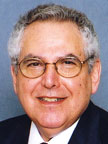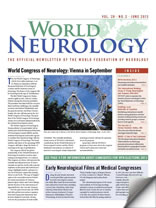I cite some of my leadership and innovative past activities as an example of my qualifications for the position as secretary-treasurer general of the WFN.
I am the H. Houston Merritt professor of Neurology and director of the Center for Parkinson’s Disease and Other Movement Disorders at Columbia University Medical Center in New York. I remain active in patient care and teaching, having trained more than 130 movement disorder fellows over the years. Throughout my career, I have been involved in clinical research, and earlier in basic science research.
I consider myself to be innovative and creative in that I came up with the idea of uniting movement disorder specialists by organizing an international society, and was able to successfully execute this activity. For this task, I asked C. David Marsden to join me in co-founding the Movement Disorder Society (a member society of the WFN). One purpose for that formation was to create a journal for the subspecialty and for it to contain videotapes of patients being described. Five leaders in the field were invited to meet in my hotel room in Hamburg in the fall of 1985 during the meeting of the World Congress of Neurology, and together we laid out the plans for the society’s founding and establishing its journal. Marsden and I became the first co-editors of Movement Disorders.
In another creative mode, I organized the World Parkinson Coalition in 2004 for the purpose of sponsoring a World Parkinson Congress, in which the participants would not only be neurologists, but would include patients, families and care providers, as well as health professionals (including non-neurologist physicians, nurses, physiotherapists, speech therapists, etc.) and neuroscientists.
The first World Parkinson Congress was held in 2006 in Washington, the second in 2010 in Glasgow, Scotland, and third will be held this October in Montreal. The congress has gathered professional societies and lay organizations as partners in sponsoring the congresses. More than 3,000 attendees participated in each of the first two congresses. The scientific program of the congress holds the interest for all of these disparate groups and has them talking to each other. This is the only Parkinson meeting in which patients and care providers play an equal role with health professionals in both organizing the meeting and speaking in it.
With the American Academy of Neurology (AAN), in my stint on the Science Committee, I came up with the arrangement for adding Poster Sessions to the annual meeting before any such sessions had been carried out at any neurology meeting. In my chairmanship of the AAN’s Education Committee, I created the concept of evening seminar case presentations, starting with the establishment of the Unusual Movement Disorder Seminars and co-chaired these with Marsden; these were so popular that we conducted two seminars at each of the annual meetings. I co-chaired these sessions for 20 years. Based on our success, other subspecialists began their own evening case presentation seminars. These continue to remain an excellent method of teaching.
I co-founded the Parkinson Study Group with Ira Shoulson; this group organizes and conducts clinical trials on Parkinson disease. I served as co-chair for its first 10 years.
As examples of my leadership roles, I was elected president of the AAN, having previously served in other officer levels. I also served as first vice president of the American Neurological Association (ANA). I was the first president of the Movement Disorder Society. In my own academic department at Columbia University, I organized and developed the Movement Disorder Division. I organized numerous international conferences on dystonia, myoclonus and Parkinson disease, and actively managed the publication of those proceedings.
I have received several honors and prizes. I was elected a member of the Institute of Medicine of the U.S. National Academies. From the AAN, I received the Robert Wartenberg Award for Outstanding Clinical Research, the A.B.Baker Award for Excellence in Neurological Education, and was the first recipient of the Movement Disorder Award. From the ANA, I was the recipient of the First Soriano Award. From the Parkinson’s Disease Foundation, I was awarded the James Parkinson Medal given once a decade. From the American Parkinson Disease Association, I received the Fred Springer Award.
I also devote some of my time to assist patient organizations. I am the scientific director of the Parkinson’s Disease Foundation. I serve on the Board of Trustees of the Dystonia Medical Research Foundation.
Vision Statement
Although I have attended many World Congresses of Neurology sponsored by the WFN, I have not been engaged at any executive level with the organization. Thus, if elected, I would come to the WFN with “fresh eyes,” and no preconceived notions. Instead, I could use my skills and knowledge from working with other organizations on how to make the WFN more meaningful to the lives of the international community of neurologists. The primary goal of neurologists is to improve neurologic health by providing care and advancing better treatments. Much of this goal is achieved by the combination of education and research. My vision of the WFN is that it should serve as a major vehicle to enable the entire world community of neurologists to better achieve this goal. The WFN is especially vital for neurologist who are not members of a subspecialty society and are located in parts of the world where there is no strong national neurological society to assist in their education.
The WFN has been the sponsor of the World Congresses of Neurology (WCN). In fact, the WFN is probably best known by neurologists for these congresses, rather than for its other activities, such as its journals. If I am elected secretary-treasurer general, I would learn about all the federation’s activities, and help make the WFN become better known by neurologists around the world. We can assist isolated neurologists by not only having them attend our congresses but by sending superior educators to visit them in areas where education has been weak.
I am pleased to say that I have attended almost all of the WCNs since I was neurology resident in the early 1960s. The WCN should be promoted to serve as a forum for neurologists, particularly those from parts of the world where no major neurological meetings are held and where no strong society promotes the interests and education of neurologists. For these neurologists, the WCN should be a magnet for a place to meet one another and learn about the latest advances in neurology.
With the AAN, I have just finished serving four years as the chair of the Meeting Management Committee. My experience in planning AAN meetings could be useful in helping the planning and execution of future WCNs. The WCN must not only be strong financially, but also must inspire neurologists from around the world to attend and obtain a valuable educational experience. Raising funds for travel grants for young neurologists, especially those in training from financially troubled parts of the world should be a tactical goal. Having these neurologists experience the WCN would introduce them to the value of these meetings, and hopefully instill in them the knowledge as to how useful the WCN can be for educational and scientific advancement.
If I am elected secretary-treasurer general, I will serve an active role and try to benefit the organization in whatever means I am capable of. Since national neurological societies are the actual members of the WFN, the WFN should reach out to these societies, and through them, to their members, to exchange ideas, on what each society’s role should be and how each can be helpful to the others. Harmony, cooperation, engagement and joint participations should be encouraged for the benefit of all.
